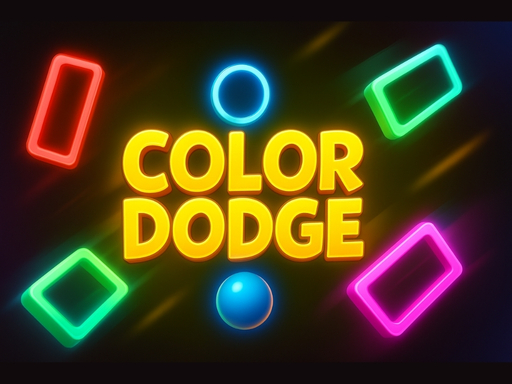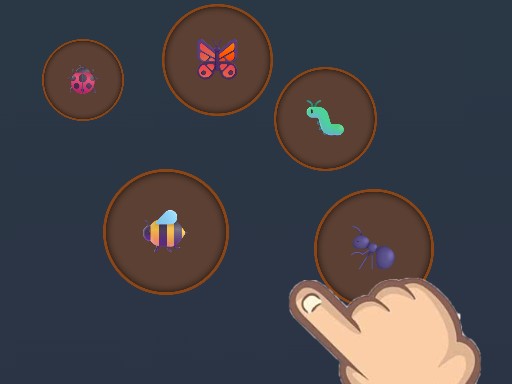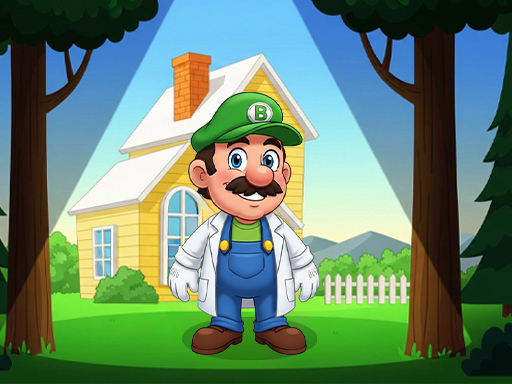Breakout Bob
About Breakout Bob
Oh man, you are *not* going to believe what I stumbled upon. Seriously, I've been completely swallowed whole by this game for the past week, and I just had to tell you about it. It’s called *Breakout Bob*, and I swear, it’s one of those hidden gems that just grabs you by the collar and doesn't let go. You know how sometimes you pick up a game, and it just *clicks*? Like it was made for exactly the kind of challenge you crave? That’s Bob for me.
I mean, look, on the surface, it sounds deceptively simple, right? You're Bob, you're in a high-security prison, and you need to escape. The whole thing plays out on a 3x3 grid. A *3x3 grid*! When I first heard that, I was like, "Okay, a mobile game, maybe a quick puzzle fix." But oh my god, that's where the genius of it lies. It’s not just a grid; it’s a living, breathing, incredibly dangerous chessboard where every single move could be your last. And I’m not exaggerating.
What I love about games like this is how they take a seemingly small space and wring every drop of tension and strategic depth out of it. You’re not just moving Bob; you’re orchestrating a desperate, high-stakes ballet of evasion and calculated risk. The prison itself, even in this abstracted grid form, feels incredibly oppressive. You can almost *feel* the cold, damp concrete, the harsh, flickering fluorescent lights, the ever-present hum of unseen machinery. The atmosphere is just thick with dread, and that's before you even see your first guard.
The brilliant thing about this setup is that it forces you to think several steps ahead. You’ll find yourself staring at that 3x3 grid, practically feeling the weight of the controller in your hands, your brow furrowed in concentration. Each square has its own personality, almost. Some are safe, for a moment. Others are death traps. You’ve got patrolling guards, right? And they’re not just static obstacles. They move in predictable, yet terrifyingly efficient patterns. You learn their routes, you anticipate their turns, you hold your breath as one passes just one square away from your hiding spot. And then, just when you think you’ve got it all figured out, they throw in the dogs.
Oh, the dogs. Honestly, the first time I heard that low, guttural growl, my heart actually jumped. It’s not just a sound effect; it’s a warning, a promise of swift, brutal failure if you make a single misstep. The dogs are faster, more unpredictable, and they cover ground in a way that just shrinks your safe zones even further. Suddenly, that carefully planned route you had for getting to the next square is completely compromised. You have to adapt, on the fly, with your pulse absolutely thrumming in your ears. That’s the visceral thrill of it, you know? That moment when your perfect plan goes sideways, and you have to pull a new strategy out of thin air, all while a pixelated dog is closing in.
Your ultimate goal, of course, is to collect three hidden map pieces and make your escape. And this isn't some casual stroll. Each map piece feels like a monumental achievement. You might spend ten minutes just observing the guard patterns on one section of the grid, trying to figure out the exact sequence of moves that will get you to that shimmering map piece without being spotted. And then, the rush when you grab it! It’s a small victory, but it feels huge, a genuine sense of accomplishment that fuels your determination for the next one.
But it’s not all just evasion. You’re not entirely helpless. There are hidden weapons and medkits scattered around. Finding a medkit? That’s like finding an oasis in the desert. You’re probably down to your last sliver of health from a near miss, or maybe you took a calculated risk that didn’t quite pay off. The relief of picking one up, knowing you’ve got a second chance, is immense. And the weapons… ah, the weapons. They’re not an "I win" button, not by a long shot. They’re a strategic resource. Do you use it on that guard who’s blocking your only path to a map piece, knowing it might alert others? Or do you save it for an emergency, for when a dog corners you and it’s your only way out? That’s the kind of decision-making that keeps you on the edge of your seat. It’s not about brute force; it’s about timing, about knowing when to strike, and when to melt back into the shadows.
There's something magical about games that can create such a profound sense of tension and reward with such minimalist design. Every failure isn't just a restart; it's a lesson. You learn the nuances of guard movement, the subtle tells of a dog's patrol, the optimal path through a gauntlet of danger. And when a strategy finally clicks into place, when you execute a perfect sequence of moves, dodging a guard, slipping past a dog, grabbing a map piece, and then making a clean getaway to a safe square – that feeling is just pure, unadulterated satisfaction. It’s that moment where your brain lights up, and you think, "Yes! I saw that. I planned that. I *did* that."
In my experience, the best moments come when you’re pushed to your absolute limit. I remember one particular level, I was on my last map piece, and the entire grid felt like it was crawling with threats. Every square was a potential trap. I must have died a dozen times, each time feeling that familiar pang of frustration, but also that insatiable desire for "just one more try." I was meticulously charting patrol routes in my head, trying to predict the exact moment a guard would turn their back, the split second I’d have to dash. And then, it happened. A series of moves, a dash, a quick pivot, a perfectly timed use of a weapon on a guard I absolutely *had* to eliminate, and then the final grab. The screen flashed, the escape route opened, and I actually let out a cheer. It wasn’t just a game; it was an escape, a triumph against overwhelming odds.
What's fascinating is how the game scales that difficulty. Just when you think you’ve mastered the basics, it introduces new elements, new types of guards, tighter patrol patterns, or more complex layouts that make that 3x3 grid feel infinitely larger and more intricate. The real magic happens when you start seeing the matrix, so to speak. You stop seeing individual squares and start seeing pathways, choke points, safe zones that are only safe for a heartbeat. You start to feel like a genuine escape artist, a master strategist, outwitting the system with nothing but your wits and a bit of luck.
Honestly, if you're into strategy games, if you love that feeling of outsmarting the AI, of meticulously planning and then executing a perfect run, then you *have* to try Breakout Bob. It's not about flashy graphics or an epic story; it's about pure, unadulterated gameplay. It’s about the tension, the challenge, and that incredible rush of satisfaction when you finally, *finally* make your escape. It’s a game that makes you lean forward in your chair, that makes your heart pound, and that will make you feel like a genius when you pull off that impossible breakout. Trust me on this one. You'll thank me later.
I mean, look, on the surface, it sounds deceptively simple, right? You're Bob, you're in a high-security prison, and you need to escape. The whole thing plays out on a 3x3 grid. A *3x3 grid*! When I first heard that, I was like, "Okay, a mobile game, maybe a quick puzzle fix." But oh my god, that's where the genius of it lies. It’s not just a grid; it’s a living, breathing, incredibly dangerous chessboard where every single move could be your last. And I’m not exaggerating.
What I love about games like this is how they take a seemingly small space and wring every drop of tension and strategic depth out of it. You’re not just moving Bob; you’re orchestrating a desperate, high-stakes ballet of evasion and calculated risk. The prison itself, even in this abstracted grid form, feels incredibly oppressive. You can almost *feel* the cold, damp concrete, the harsh, flickering fluorescent lights, the ever-present hum of unseen machinery. The atmosphere is just thick with dread, and that's before you even see your first guard.
The brilliant thing about this setup is that it forces you to think several steps ahead. You’ll find yourself staring at that 3x3 grid, practically feeling the weight of the controller in your hands, your brow furrowed in concentration. Each square has its own personality, almost. Some are safe, for a moment. Others are death traps. You’ve got patrolling guards, right? And they’re not just static obstacles. They move in predictable, yet terrifyingly efficient patterns. You learn their routes, you anticipate their turns, you hold your breath as one passes just one square away from your hiding spot. And then, just when you think you’ve got it all figured out, they throw in the dogs.
Oh, the dogs. Honestly, the first time I heard that low, guttural growl, my heart actually jumped. It’s not just a sound effect; it’s a warning, a promise of swift, brutal failure if you make a single misstep. The dogs are faster, more unpredictable, and they cover ground in a way that just shrinks your safe zones even further. Suddenly, that carefully planned route you had for getting to the next square is completely compromised. You have to adapt, on the fly, with your pulse absolutely thrumming in your ears. That’s the visceral thrill of it, you know? That moment when your perfect plan goes sideways, and you have to pull a new strategy out of thin air, all while a pixelated dog is closing in.
Your ultimate goal, of course, is to collect three hidden map pieces and make your escape. And this isn't some casual stroll. Each map piece feels like a monumental achievement. You might spend ten minutes just observing the guard patterns on one section of the grid, trying to figure out the exact sequence of moves that will get you to that shimmering map piece without being spotted. And then, the rush when you grab it! It’s a small victory, but it feels huge, a genuine sense of accomplishment that fuels your determination for the next one.
But it’s not all just evasion. You’re not entirely helpless. There are hidden weapons and medkits scattered around. Finding a medkit? That’s like finding an oasis in the desert. You’re probably down to your last sliver of health from a near miss, or maybe you took a calculated risk that didn’t quite pay off. The relief of picking one up, knowing you’ve got a second chance, is immense. And the weapons… ah, the weapons. They’re not an "I win" button, not by a long shot. They’re a strategic resource. Do you use it on that guard who’s blocking your only path to a map piece, knowing it might alert others? Or do you save it for an emergency, for when a dog corners you and it’s your only way out? That’s the kind of decision-making that keeps you on the edge of your seat. It’s not about brute force; it’s about timing, about knowing when to strike, and when to melt back into the shadows.
There's something magical about games that can create such a profound sense of tension and reward with such minimalist design. Every failure isn't just a restart; it's a lesson. You learn the nuances of guard movement, the subtle tells of a dog's patrol, the optimal path through a gauntlet of danger. And when a strategy finally clicks into place, when you execute a perfect sequence of moves, dodging a guard, slipping past a dog, grabbing a map piece, and then making a clean getaway to a safe square – that feeling is just pure, unadulterated satisfaction. It’s that moment where your brain lights up, and you think, "Yes! I saw that. I planned that. I *did* that."
In my experience, the best moments come when you’re pushed to your absolute limit. I remember one particular level, I was on my last map piece, and the entire grid felt like it was crawling with threats. Every square was a potential trap. I must have died a dozen times, each time feeling that familiar pang of frustration, but also that insatiable desire for "just one more try." I was meticulously charting patrol routes in my head, trying to predict the exact moment a guard would turn their back, the split second I’d have to dash. And then, it happened. A series of moves, a dash, a quick pivot, a perfectly timed use of a weapon on a guard I absolutely *had* to eliminate, and then the final grab. The screen flashed, the escape route opened, and I actually let out a cheer. It wasn’t just a game; it was an escape, a triumph against overwhelming odds.
What's fascinating is how the game scales that difficulty. Just when you think you’ve mastered the basics, it introduces new elements, new types of guards, tighter patrol patterns, or more complex layouts that make that 3x3 grid feel infinitely larger and more intricate. The real magic happens when you start seeing the matrix, so to speak. You stop seeing individual squares and start seeing pathways, choke points, safe zones that are only safe for a heartbeat. You start to feel like a genuine escape artist, a master strategist, outwitting the system with nothing but your wits and a bit of luck.
Honestly, if you're into strategy games, if you love that feeling of outsmarting the AI, of meticulously planning and then executing a perfect run, then you *have* to try Breakout Bob. It's not about flashy graphics or an epic story; it's about pure, unadulterated gameplay. It’s about the tension, the challenge, and that incredible rush of satisfaction when you finally, *finally* make your escape. It’s a game that makes you lean forward in your chair, that makes your heart pound, and that will make you feel like a genius when you pull off that impossible breakout. Trust me on this one. You'll thank me later.
Enjoy playing Breakout Bob online for free on Qotori games. This Arcade game offers amazing gameplay and stunning graphics. No downloads required, play directly in your browser!
How to Play
Arrows or WASD





Comments
This game is awesome! I love the graphics and gameplay.
One of the best games I've played recently. Highly recommended!